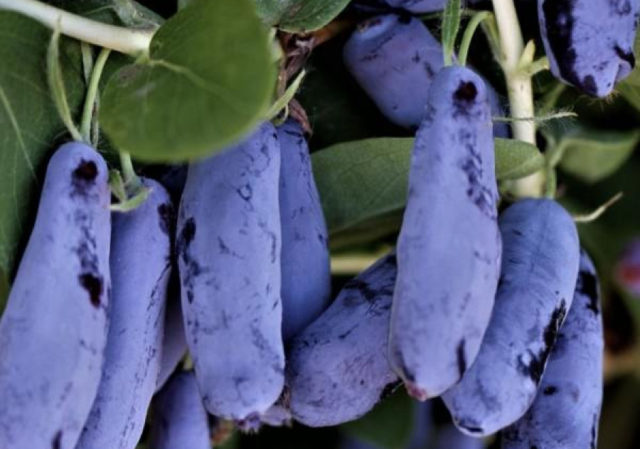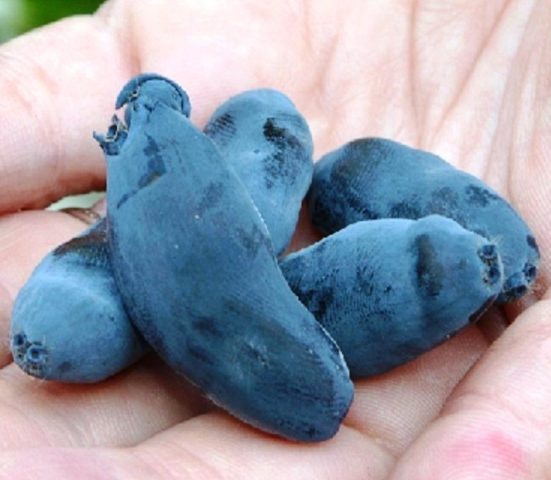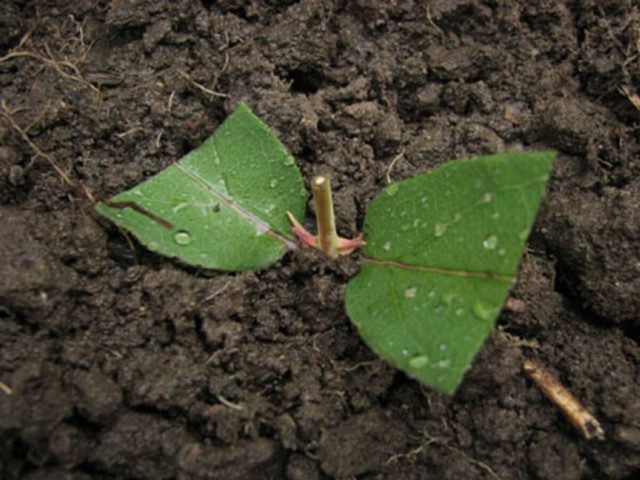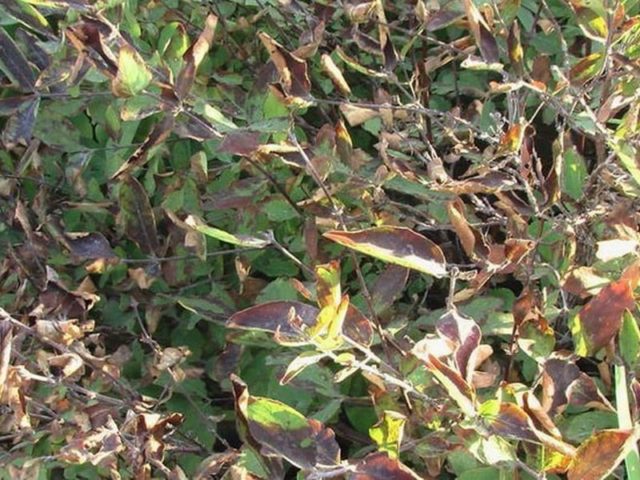Content
More than 190 plant species of the Honeysuckle family are known. It grows mainly in the Himalayas and East Asia. Some wild species are found on the territory of the Russian Federation. One of the newest early-ripening varieties is the bush of the Tomsk enterprise "Bakcharskoye": a detailed description of the Strezhevchanka honeysuckle variety, methods of its reproduction, planting and care features.
Description of honeysuckle variety Strezhevchanka
Edible honeysuckle (lonicera edulis) Strezhevchanka belongs to vigorous early varieties. The bush up to 180 cm high and 1.5 meters in diameter has straight, spreading branches. The foliage is dark green, slightly dull. The variety is dessert, with high taste. The plant blooms in May and continues to form buds for 15-20 days. The most plentiful harvests can be expected from the fifth year after planting, and then within 3-5 years, depending on the care. Then the yield begins to decline.
Record large berries, weighing up to 3 g, ripen abundantly and amicably, do not crumble. It is easy to collect them, since the arrangement of the branches is rather sparse, and the fruits are located at the very tips. They are covered with a waxy coating, dark blue, almost black, fusiform. Sweet and sour, juicy, with a thin skin. They ripen in the first half of June. The yield of the bush on average reaches 2.4-2.8 kg of berries per bush, and with proper care and a favorable climate, it can reach up to 4.5 kg. The disadvantages of the variety include the impossibility of machine picking of ripe berries and poor resistance to transportation due to increased juiciness and thin skin.

Honeysuckle Strezhevchanka is a standard crop that needs proper pruning.
Planting and caring for Strezhevchan honeysuckle
Like any other variety of honeysuckle, Strezhevchanka is unpretentious and very hardy. However, comfortable conditions are the key to a bountiful harvest, so you should follow the rules of planting and caring for it.

Ripe fruits become soft, very tender
Landing dates
Honeysuckle Strezhevchanka is an early maturing variety, waking up from sleep with the first warm days. Therefore, the best option would be an autumn planting, at least a month before freezing temperatures. The exact time frame depends on the region. If in the northern and central regions of Russia it is September, then in the southern regions planting can be carried out until October-early November.
Selection and preparation of the landing site
Wild varieties of honeysuckle prefer sunny, open areas near woodlands and water bodies:
- old felling and burning;
- forest glades and meadows;
- edges and outskirts of overgrown swamps;
- banks of rivers, lakes, streams, damp ravines.
Withstands shrubs and light shading.Therefore, when preparing the landing site, it is worth considering the natural characteristics of honeysuckle. For Honeysuckle Strezhevchanka you need:
- open, maximum illuminated place;
- protection from wind and drafts;
- well warmed up soil.
The southern slopes of hills, areas next to blank fences and walls of houses or outbuildings, open courtyards are perfect. Strezhevchanka honeysuckle is undemanding to the composition of the soil. The following types are allowed:
- peat bogs and gray forest;
- loams and alumina;
- black soil and sandy loam;
- sod-podzolic and volcanic sand.
The acid-base balance of the soil, at which the plant feels comfortable, is also very wide - from 4.5 to 7.5 pH. Provide honeysuckle with a high mineral and nutrient content.
Landing rules
At the chosen place, it is necessary to dig a hole 40x40 in size and 50 cm deep. The edges should be strictly vertical, and the bottom should be even, horizontal. First, a layer of drainage is poured from turf, crushed stone, broken brick and pebbles 8-10 cm high.Then you should prepare a fertile soil mixture by mixing 1-2 buckets of compost, a liter of ash, half a bucket of humus and 50 g of superphosphate into the selected soil. If the soil is too heavy, you can add a baking powder in the form of sand. Pits should be prepared 1-2 weeks before planting.
If the seedling has an open root system, then the soil should be poured with a slide so that the root collar is on the surface, and the roots can be freely straightened. Then the bush must be carefully sprinkled with soil and lightly crushed by hand. If the plant is planned to be planted by transshipment from a pot, then the hole should be filled in such a way that the root ball stands on the ground without deepening the upper part - it should be flush with the soil level.
The planted plants must be well shed with water and mulched with any convenient material, from chopped straw and agrofibre to peat, husks or grass cuttings.

Honeysuckle Strezhevchanka in the third year after planting
Watering and feeding
Proper care of the shrub involves regular watering, 3-4 times during the period of active flowering, after harvest and in the fall. Fertilization is necessary for 2-3 years after planting in the ground. Before flowering, top dressing with urea, and after harvesting, spill with mullein solution. Strezhevchan's honeysuckle is especially sensitive to the presence of potassium and phosphorus in the nutrient substrate. Therefore, in the fall, it is necessary to fertilize the plantings with superphosphate and potassium salt.
Pruning honeysuckle variety Strezhevchanka
It is best to form a crown using a standard method - this greatly simplifies care and harvesting. Pruning should be done in late autumn, when the flow of juices slows down from the age of six. Young apical shoots are not touched, since it is on them that the future harvest is formed. For young plants, sanitary pruning is practiced, with the removal of dried, diseased, damaged branches. The old bush can be cut to the height of the trunk. This rejuvenation allows you to give a second life to the plant and get full yields over the next years.
Wintering
Honeysuckle Strezhevchanka does not need special preparation for winter. In the fall follows:
- it is good to shed falling asleep bushes;
- carry out pruning and feeding;
- remove old foliage;
- loosen, renew the mulch layer.
Reproduction of edible honeysuckle Strezhevchanka
Honeysuckle Strezhevchanka can reproduce in the following ways:
- by cuttings. To do this, you need to choose strong shoots 2-4 years of age, 14-18 cm long with several living buds. The top cut should be straight, the bottom cut at an angle. Remove the leaves, except for those that remain on the top, cut them in half.Place vertically in light, fertile soil, under a glass jar. After 2-3 weeks, the rooted cutting can be transplanted into open ground;
- dividing the bush. It should be produced either in March or October. Dig the selected bush on one side, cut off several branches along with pieces of root, plant it on a permanent place of residence;
- layering. To obtain shoots, the lower branches should be bent to the ground, secured and dug in. Secure the upper parts with pegs vertically. Shed a rooting stimulant. When new shoots appear and grow, they should be carefully separated from the mother branch, leaving each piece with a rhizome, and transplanted.
Thus, from one bush of Strezhevchank honeysuckle, you can get 5-10 new plants per season.

Rooted stalk of honeysuckle Strezhevchanka
Honeysuckle pollinators Strezhevchanka
To increase yields, it is recommended to plant several varieties of honeysuckle side by side to ensure cross-pollination. Strezhevchanka reacts with a record number of berries in the presence of such pollinators as:
- honeysuckle Delight and Yugan;
- Bakchar giant;
- The daughter of a giant and Silginka.
To ensure pollination, one of the above species is enough for 5-6 bushes.
Diseases and pests
Honeysuckle Strezhevchanka demonstrates a unique immunity to common diseases of shrubs. Therefore, the main care lies in preventive measures, including folk remedies:
- modern fungicides, sulfur, urea help well against fungal diseases;
- bacterial and viral infections are not terrible for a strong, healthy plant that has good immunity;
- from aphids help treatment with alkaline solutions, ash, soda ash, laundry soap;
- spraying with iodine preparations, serum, infusions of tomato and potato tops, plants, whose smell is unbearable for insects, have shown themselves well;
- if mass accumulations of insects are found that threaten the planting of honeysuckle, you should resort to industrial insecticides.

Honeysuckle bushes Strezhevchanka affected by aphids
Conclusion
The description of the Strezhevchanka honeysuckle variety, given by the breeders, attracted the attention of gardeners. Despite the fact that the official testing of the variety has not yet been completed, Strezhevchanka's honeysuckle has already managed to establish itself in the most positive way. A tall shrub with straight branches begins flowering in May, and fruits appear in June-July. Honeysuckle Strezhevchanka gives very juicy berries, with a thin skin and a sweet-sour taste. They have high dessert qualities, they are a storehouse of vitamins and minerals useful for the body. Suitable for use in cooking, both fresh and processed.








